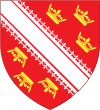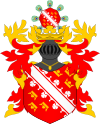Flag of Alsace
- View a machine-translated version of the French article.
- Machine translation, like DeepL or Google Translate, is a useful starting point for translations, but translators must revise errors as necessary and confirm that the translation is accurate, rather than simply copy-pasting machine-translated text into the English Wikipedia.
- Consider adding a topic to this template: there are already 6,211 articles in the main category, and specifying
|topic=will aid in categorization. - Do not translate text that appears unreliable or low-quality. If possible, verify the text with references provided in the foreign-language article.
- You must provide copyright attribution in the edit summary accompanying your translation by providing an interlanguage link to the source of your translation. A model attribution edit summary is
Content in this edit is translated from the existing French Wikipedia article at [[:fr:Drapeau de l'Alsace]]; see its history for attribution. - You may also add the template
{{Translated|fr|Drapeau de l'Alsace}}to the talk page. - For more guidance, see Wikipedia:Translation.
 | |
| Rot un Wiss | |
| Adopted | 11th century |
|---|---|
| Design | Red and white |
| Designed by | Gérard d'Alsace, Duke of Lorraine |
 The official flag of Alsace 2008–present | |
| Part of a series on |
| Alsace |
|---|
Rot un Wiss, traditional flag of Alsace |
| History
|
|
|
|
|
| Alsace in the European Union
|
| Related topics |
 |
|
The flag of Alsace (Alsatian: Rot un Wiss or Rot-un-Wiss, "red and white") is the original red and white flag of the region, and can be traced to the red and white banner of Gerard, Duke of Lorraine in the 11th century.
Particularly since the introduction of new French region Grand Est, the traditional Rot un Wiss flag of Alsace has been widely promoted by the advocates of the Alsace autonomous movement.
History
Rot un Wiss (from the 11th century)
The original flag of Alsace, the Rot un Wiss, dates back to the red and white banner[1] of Gerard, Duke of Lorraine in the 11th century.
Red and white colours are commonly found on the coat of arms of Alsatian cities such as Strasbourg, Mulhouse and Sélestat,[2] and additionally of many Swiss cities, especially in the region of Basel-Landschaft.
Departmental and regional flags
Perhaps as the Rot un Wiss marks the Germanic roots of Alsace, it was replaced in 1949 by a new flag, representing the union of the two départements of Haut-Rhin and Bas-Rhin, however without real historical relevance. It was subsequently modified to a slightly different appearance, yet also representing the two departments. The flag is currently used by the European Collectivity of Alsace created in January 2021.[3]
-
 Prince-Bishopric of Strasbourg (982–1803)
Prince-Bishopric of Strasbourg (982–1803) -
 Imperial Territory of Alsace-Lorraine (1871–1918)
Imperial Territory of Alsace-Lorraine (1871–1918) -
 Unofficial flag of Alsace from the beginning of the 20th century, used by supporters of increasing autonomy.
Unofficial flag of Alsace from the beginning of the 20th century, used by supporters of increasing autonomy. -
 Alsace-Lorraine Soviet Republic, red flag (1918)
Alsace-Lorraine Soviet Republic, red flag (1918) -

-
 The official flag of Alsace 2008–present
The official flag of Alsace 2008–present -
 Flag of the former Region of Alsace 2011-2016
Flag of the former Region of Alsace 2011-2016 -
 Official logo of the European Collectivity of Alsace 2021–present
Official logo of the European Collectivity of Alsace 2021–present
Recognition
There is controversy around the recognition of the Alsatian flag.
With the purpose of "Francosizing" the region, the Rot un Wiss has not been recognised by the French government. Some French politicians have erroneously called this a "Nazi invention" — while the Rot un Wiss is still known as the real historical emblem of the region by most of the population and the departments' parliaments.
Subsequently, the Rot un Wiss has been widely used during protests against the creation of a new "super-region" Grand Est, gathering Champagne-Ardennes, Lorraine and Alsace, namely on Colmar's statue of liberty.[4]
See also
References
- ^ Image genealogie-bisval.net
- ^ "Brève histoire du drapeau alsacien". Archived from the original on 17 October 2019. Retrieved 17 October 2019.
- ^ @lalsace (28 June 2021). "La composition du nouveau conseil départemental d'Alsace -" (Tweet) – via Twitter.
- ^ "Colmar : une statue de la Liberté en "Rot und Wiss"". France 3 Grand Est. 16 November 2014. Retrieved 17 October 2019.
 | This France-related article is a stub. You can help Wikipedia by expanding it. |
- v
- t
- e
 | This European flag–related article is a stub. You can help Wikipedia by expanding it. |
- v
- t
- e























